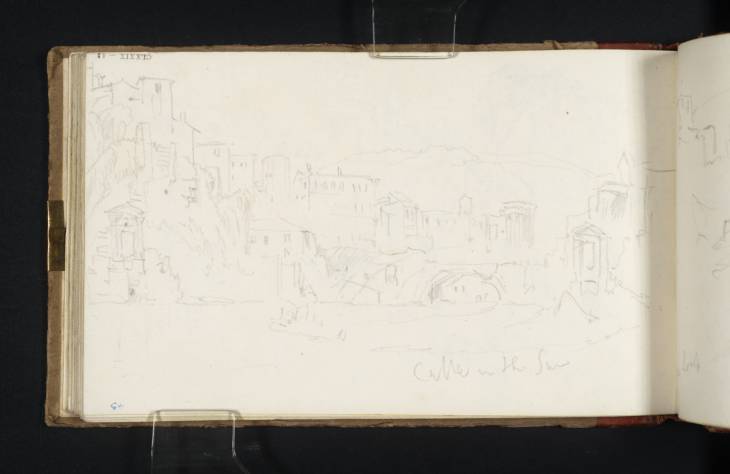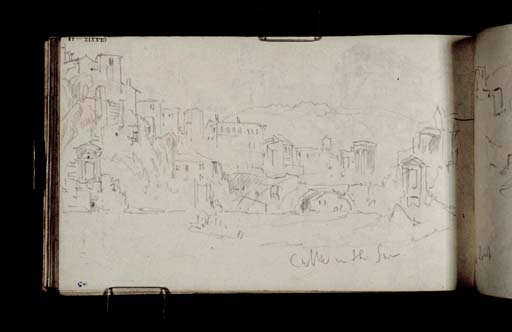Joseph Mallord William Turner Ponte San Rocco, Tivoli, looking towards the So-Called Temple of Vesta 1819
Image 1 of 2
Joseph Mallord William Turner,
Ponte San Rocco, Tivoli, looking towards the So-Called Temple of Vesta
1819
Joseph Mallord William Turner 1775–1851
Folio 43 Recto:
Ponte San Rocco, Tivoli, looking towards the So-Called Temple of Vesta 1819
D15006
Turner Bequest CLXXIX 43
Turner Bequest CLXXIX 43
Pencil on white wove paper, 112 x 186 mm
Inscribed by the artist in pencil ‘Cattle in the Sun’ bottom right
Inscribed by ?John Ruskin in blue ink ‘43’ bottom left, inverted
Stamped in black ‘CLXXIX 43’ top left, inverted
Inscribed by the artist in pencil ‘Cattle in the Sun’ bottom right
Inscribed by ?John Ruskin in blue ink ‘43’ bottom left, inverted
Stamped in black ‘CLXXIX 43’ top left, inverted
Accepted by the nation as part of the Turner Bequest 1856
References
1909
A.J. Finberg, A Complete Inventory of the Drawings of the Turner Bequest, London 1909, vol.I, p.528 as ‘Bridge, with buildings on hill. (?Convent of San Cosimato, on the Teverone, about 8 miles above Tivoli.)’.
2003
David Hill, ‘J.M.W. Turner: From the World to Art and Back Again: The 2003 Kurt Pantzer Memorial Lecture’, in Turner Society News, no.95, December 2003, pp.12, 16 note 27.
This sketch depicts a view of Tivoli looking north towards the former falling point of the River Aniene and the Ponte San Rocco, a wooden crossing erected upon the foundations of a previous stone structure swept away in a flood in 1808. Turner’s location is the eastern bank of the river, at a point just before the water tips over the brink of the gorge immediately in front of the bridge and falls away in cascades. Visible on the spur of land beyond is the so-called Temple of Vesta, a circular ruin dating from the first century BC, which stands at the top of the Valle d’Inferno (Valley of Hell) at the north-eastern edge of the town. The bell-tower on the far right-hand side belongs to the Church of Santa Maria del Ponte. Similar compositions can be found on folios 44, 63 verso– 64 verso and 77 verso (D15008, D15045–D15047, D15072). Turner also recorded the view looking towards the bridge from the opposite direction, see folios 2 verso, 3 and 89 verso (D14936, D14937 and D15096), and in the Tivoli sketchbook (Tate D15494; Turner Bequest CLXXXIII 27).
The picturesque position of the Ponte San Rocco made it a popular subject for artists, and by the early nineteenth century it was a well-established topographical motif. The vista in Turner’s sketch is similar to that in paintings by Louis Ducros (1748–1810),1 and in an engraving by Luigi Rossini (1790–1857).2 However, it is no longer possible to find the same prospect in present-day Tivoli. A devastating flood in 1826 persuaded Pope Gregory XVI to divert the course of the river away from the residential district. Consequently, the town’s many waterfalls, including the Grand Cascade near to the Temple of Vesta, were replaced instead by the great waterfall in the Villa Gregoriana to the north-east of the town. Furthermore, the topography of the town was greatly altered and the wooden Ponte San Rocco was succeeded by the newly-built Ponte Gregoriano.
Nicola Moorby
February 2010
See Pierre Chessex, Lindsay Stainton, Luc Boissanas et al, Images of the Grand Tour: Louis Ducros 1748–1810, exhibition catalogue, Iveagh Bequest, Kenwood 1985, nos.18–20, reproduced.
How to cite
Nicola Moorby, ‘Ponte San Rocco, Tivoli, looking towards the So-Called Temple of Vesta 1819 by Joseph Mallord William Turner’, catalogue entry, February 2010, in David Blayney Brown (ed.), J.M.W. Turner: Sketchbooks, Drawings and Watercolours, Tate Research Publication, December 2012, https://www


